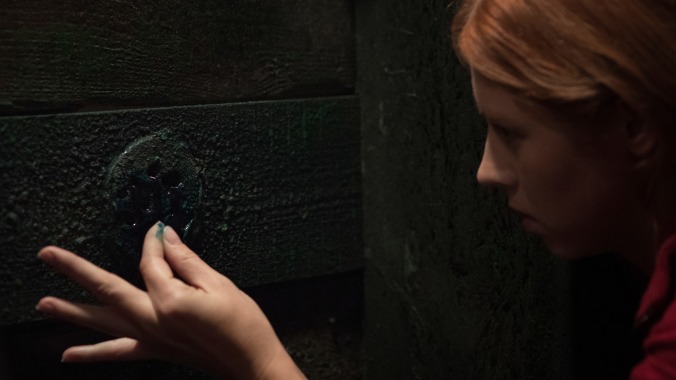Sea Fever is the accidental zeitgeist horror movie of our isolated here and now


Every movie is now a horror movie. To watch even, say, an innocuous romantic comedy is to feel shudders of instinctive unease, triggered by scenes of people hugging or attending a concert or not spending the entire running time washing their hands. Of course, some films might actually benefit, so to speak, from the anxiety we’re bringing to them. Take, for example, Sea Fever. Set aboard an Irish fishing boat that becomes infested with deadly aquatic parasites, this modestly scaled sci-fi thriller isn’t going to win any points for originality—it’s well-acted and reasonably intelligent, but also derivative enough to compare unfavorably to plenty of stone-cold classics. Thing (or The Thing) is, it’s hard to dwell too much on these superior monster movies when the mind is leaping instead to parallels between the events on screen and those unfolding in real life. Which is to say, Sea Fever’s portrait of ordinary people in close quarters, stressing about a highly transmittable threat, now looks like an accidental zeitgeist movie—a horror picture for our awful here and now. It could only be more unnervingly topical if it took place on a cruise ship instead.
The film’s heroine, a graduate student with a rather scientific remove from everyone in her life, probably looks a little more sympathetic today than she did half a year ago, when Sea Fever premiered on the festival circuit. “I don’t do joining,” Siobhán (Hermione Corfield) tells her professor when he encourages her to step away from the microscope to have cake with her classmates; she’s a social distancing pro before it was cool. That unfriendliness, combined with a superstition that red hair is bad luck at sea, puts her immediately at odds with the crew of the trawler she boards to collect research for her thesis. But her coldly analytical nature also comes in handy when some underwater anomaly—an enormous squidlike creature—attaches its glowing tendrils to the ship, locking it in place like an anchor. The real danger is what it unleashes through the hull: a shiny goo from which tiny, vicious spawn hatch, immediately seeking out the nearest open wound or orifice to squirm into. The ickiest part? They like to hang out in the eyes, which is useful for detection but also one of the last places you’d want a hostile organism to set up shop.
Again, all of this may inspire a flash of déjà vu for anyone possessing even a passing familiarity with films about a small group of blue-collar workers facing off against an invasive creature in isolation. The crew, which includes a salty captain (Connie Nielsen), her husband and first mate (Dougray Scott), and the sensitive stud (Jack Hickey) Siobhán takes a shine to, is a seafaring variation on the intergalactic manifest of the Nostromo. (There’s even a jocular dinner-table scene right before all hell breaks loose.) To that DNA Sea Fever also adds a drop of John Carpenter’s blood, subbing out a petri dish and a flamethrower for a flashlight shined directly into the pupil of the potentially infected. Meanwhile, a detour to a larger vessel the characters spot floating ominously in the distance evokes both genre milestones, plus their countless toothy offspring.
Honestly, writer-director Neasa Hardiman, a TV veteran who helmed a couple episodes of Jessica Jones, might have been better off emulating her influences more shamelessly, or at least a bit more emphatically. Beyond her pretty gnarly spin on Alien’s famous chest-buster sequence, nothing here rises to comparable levels of intensity, paranoia, or queasiness. Then again, there’s also something refreshing about Sea Fever’s minimalism—the way it keeps everything in the realm of both plausible behavior and some semblance of “realism.” Armed with a presumably limited budget, Hardiman resists tilting the action into full-scale Hollywood bombast; she deploys her effects sparingly, which is a plus, because they’re much less convincing than her cast’s distressed reaction to them. Likewise, there are few displays of superhuman fortitude: Only Siobhán, in her emotional detachment, approaches anything like steeliness, her shipmates responding instead with credible fear, panic, and tears.
One might wish that the film better amplified the drama of its claustrophobic scenario. At 89 minutes, it’s almost too fleet to properly set up the primary conflict between steadfast pragmatism and the more messily human impulses of everyone else on board; schematic though that divide is, Sea Fever tackles it with almost too much restraint—this material called for a few more shouting matches. All the same, there’s no denying that the movie eventually reaches a confrontation of disturbing relevance. Faced with the probability that one or all of them are infected with this highly fast-moving parasite, Siobhán makes the case that they can’t return to dry land until they know for sure they’re not—a logical conclusion that’s met with understandable but illogical resistance. In other words, Sea Fever becomes a horror movie about someone trying to convince people to stay in quarantine for the sake of everyone else. It’s science fiction mostly in the possibility that she could succeed.